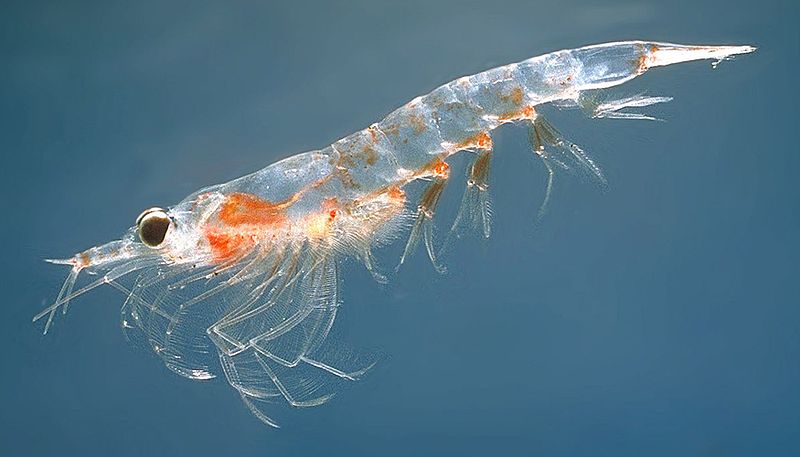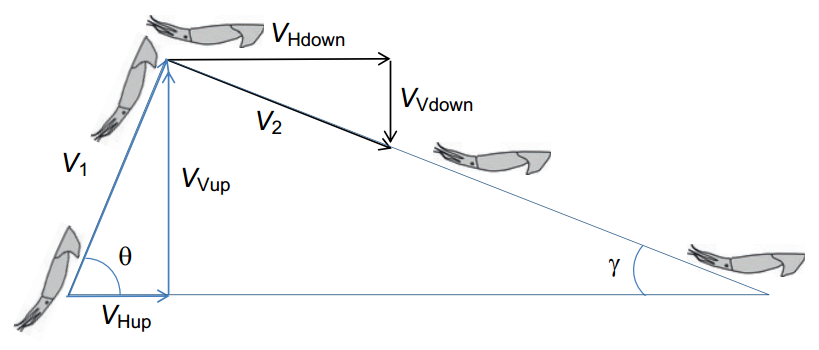
Little glowing fish called lanternfish and the similarly sized, shrimplike krill are creatures worthy of pity. They're on the menu of almost every large marine animal you can name: from tuna to penguins to whales, and, of course, squid. Most notably Humboldt squid, who stuff their beaks with truly epic quantities of these small fry.
 But in the eastern Pacific Ocean, lanternfish and krill have found a refuge from predation: a layer of deep water called the oxygen minimum zone (OMZ). The OMZ is generated by microbes breaking down organic matter as it sinks from the surface and slowly sucking the oxygen out of the water. Lanternfish and krill have adapted to life in these suffocating conditions. During the day, they hide out in the OMZ, presumably thumbing their noses (finning their snouts? thoracopoding their cephalons?) at the predators who daren't risk asphyxiation to come after them. At night, they swim to the surface to feed, trusting in darkness for protection. (And that's diurnal migration!)
But in the eastern Pacific Ocean, lanternfish and krill have found a refuge from predation: a layer of deep water called the oxygen minimum zone (OMZ). The OMZ is generated by microbes breaking down organic matter as it sinks from the surface and slowly sucking the oxygen out of the water. Lanternfish and krill have adapted to life in these suffocating conditions. During the day, they hide out in the OMZ, presumably thumbing their noses (finning their snouts? thoracopoding their cephalons?) at the predators who daren't risk asphyxiation to come after them. At night, they swim to the surface to feed, trusting in darkness for protection. (And that's diurnal migration!)It seems like a sweet deal. But Humboldt squid really don't like having noses thumbed at them--or maybe they're just extremely hungry--because they will plunge right into that OMZ and stay there all day. Lanternfish and krill, beware!
Intrigued by the apparent low-oxygen tolerance of an animal as large and active animal as the Humboldt squid, scientists plopped some squid into low-oxygen water in the laboratory and found out that the squid survived by drastically slowing their metabolism. That was six years ago. What has continued to elude researchers since then is an understanding of how this reduced metabolism jives with data from the wild that showed squid still swimming actively within the OMZ.
Now, with new research published in the Journal of Experimental Biology, Stanford professor William Gilly and colleagues have shown that Humboldt squid in the wild do, in fact, slow down in the OMZ--about as much as you'd expect based on the laboratory studies. Previous work just wasn't capturing data at a fine enough resolution to see it.
The new data show that squid spend plenty of time swimming slowly regardless of where they are. This slow swimming isn't affected much by the OMZ, but medium and fast speeds are. When hanging out in low-oxygen water, Humboldt squid cut higher speeds in half, and swim less frequently at their maximum speeds.
Gilly and his fellow scientists also found that Humboldt squid both in and out of the OMZ save energy by using a classic trick called "climb-and-glide." It looks like this:

Figure 4 from Gilly et al. 2012.
Basically, the squid swims up, then lets itself sink back to its original position, then swims up, then sinks, swims up and sinks, in a repetitive cycle. During the sinking, the squid's body and fins are angled for maximum lift, so it can cover considerable horizontal distance without expending any additional energy. As it turns out, Humboldt squid spend the majority of their time gliding passively!
Climb-and-glide is known in a variety of marine animals, including yellowfin tuna, and similar techniques have been used by humans to make more efficient use of fuel. This leads me to wonder: if squid aren't the only ones who've figured out climb-and-glide, why do they seem to be the only predators who've figured out how to take advantage of the OMZ with metabolic slowdown? Is there something about squid that's uniquely suited to this adaptation? Why haven't any tuna, for example, gotten with the program? Questions for another day . . .

Photo credit: MBARI





Comments